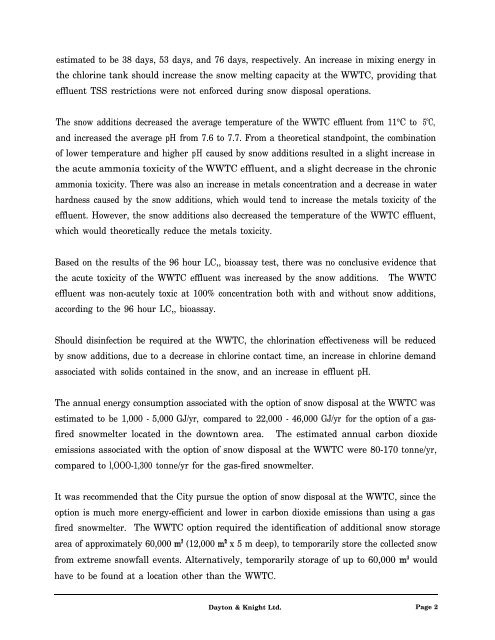City of Prince George - Snow Disposal at the Lansdowne Road ...
City of Prince George - Snow Disposal at the Lansdowne Road ...
City of Prince George - Snow Disposal at the Lansdowne Road ...
Create successful ePaper yourself
Turn your PDF publications into a flip-book with our unique Google optimized e-Paper software.
estim<strong>at</strong>ed to be 38 days, 53 days, and 76 days, respectively. An increase in mixing energy in<br />
<strong>the</strong> chlorine tank should increase <strong>the</strong> snow melting capacity <strong>at</strong> <strong>the</strong> WWTC, providing th<strong>at</strong><br />
effluent TSS restrictions were not enforced during snow disposal oper<strong>at</strong>ions.<br />
The snow additions decreased <strong>the</strong> average temper<strong>at</strong>ure <strong>of</strong> <strong>the</strong> WWTC effluent from 11°C to 5ºC,<br />
and increased <strong>the</strong> average pH from 7.6 to 7.7. From a <strong>the</strong>oretical standpoint, <strong>the</strong> combin<strong>at</strong>ion<br />
<strong>of</strong> lower temper<strong>at</strong>ure and higher pH caused by snow additions resulted in a slight increase in<br />
<strong>the</strong> acute ammonia toxicity <strong>of</strong> <strong>the</strong> WWTC effluent, and a slight decrease in <strong>the</strong> chronic<br />
ammonia toxicity. There was also an increase in metals concentr<strong>at</strong>ion and a decrease in w<strong>at</strong>er<br />
hardness caused by <strong>the</strong> snow additions, which would tend to increase <strong>the</strong> metals toxicity <strong>of</strong> <strong>the</strong><br />
effluent. However, <strong>the</strong> snow additions also decreased <strong>the</strong> temper<strong>at</strong>ure <strong>of</strong> <strong>the</strong> WWTC effluent,<br />
which would <strong>the</strong>oretically reduce <strong>the</strong> metals toxicity.<br />
Based on <strong>the</strong> results <strong>of</strong> <strong>the</strong> 96 hour LC,, bioassay test, <strong>the</strong>re was no conclusive evidence th<strong>at</strong><br />
<strong>the</strong> acute toxicity <strong>of</strong> <strong>the</strong> WWTC effluent was increased by <strong>the</strong> snow additions. The WWTC<br />
effluent was non-acutely toxic <strong>at</strong> 100% concentr<strong>at</strong>ion both with and without snow additions,<br />
according to <strong>the</strong> 96 hour LC,, bioassay.<br />
Should disinfection be required <strong>at</strong> <strong>the</strong> WWTC, <strong>the</strong> chlorin<strong>at</strong>ion effectiveness will be reduced<br />
by snow additions, due to a decrease in chlorine contact time, an increase in chlorine demand<br />
associ<strong>at</strong>ed with solids contained in <strong>the</strong> snow, and an increase in effluent pH.<br />
The annual energy consumption associ<strong>at</strong>ed with <strong>the</strong> option <strong>of</strong> snow disposal <strong>at</strong> <strong>the</strong> WWTC was<br />
estim<strong>at</strong>ed to be 1,000 - 5,000 GJ/yr, compared to 22,000 - 46,000 GJ/yr for <strong>the</strong> option <strong>of</strong> a gasfired<br />
snowmelter loc<strong>at</strong>ed in <strong>the</strong> downtown area. The estim<strong>at</strong>ed annual carbon dioxide<br />
emissions associ<strong>at</strong>ed with <strong>the</strong> option <strong>of</strong> snow disposal <strong>at</strong> <strong>the</strong> WWTC were 80-170 tonne/yr,<br />
compared to l,OOO-1,300 tonne/yr for <strong>the</strong> gas-fired snowmelter.<br />
It was recommended th<strong>at</strong> <strong>the</strong> <strong>City</strong> pursue <strong>the</strong> option <strong>of</strong> snow disposal <strong>at</strong> <strong>the</strong> WWTC, since <strong>the</strong><br />
option is much more energy-efficient and lower in carbon dioxide emissions than using a gas<br />
fired snowmelter. The WWTC option required <strong>the</strong> identific<strong>at</strong>ion <strong>of</strong> additional snow storage<br />
area <strong>of</strong> approxim<strong>at</strong>ely 60,000 m3 (12,000 m2 x 5 m deep), to temporarily store <strong>the</strong> collected snow<br />
from extreme snowfall events. Altern<strong>at</strong>ively, temporarily storage <strong>of</strong> up to 60,000 m3 would<br />
have to be found <strong>at</strong> a loc<strong>at</strong>ion o<strong>the</strong>r than <strong>the</strong> WWTC.<br />
Dayton & Knight Ltd. Page 2














